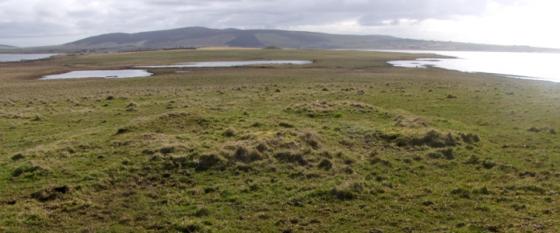Almost opposite the Viewpoint grounds on the right-hand side of the road the footpath is better marked now – though the sign is smaller it now looks to go all the way. So up in front of the house and turn the corner it is the second field from the road. I thought my eyes were playing tricks on me but the fence is indeed ‘missing’ a lower half, and as the ground was virtually dry one not so low roll and I was in (maybe you will find the proper way in further along the track). Not much marshy now. Stands out a little better closer to. A mound like a jelly mould with two tiers, the official record a mound with platform [as with Howe Harper] but they are of about equal depth so I hae my doots. Perhaps the upper part once stood as high as Howe Harper and a covering cairn has been robbed. But what looks to be an excavation on the top indicates it has always been about this height [unless the livestock are responsible]. Like that cairn exposed areas show an earth matrix with some small irregular stones (fragments?) and other stoney material. With the surrounding shallow ditch and encircling low bank it now presents a certain Henge-like appearance. The latest official record castigates the earlier report but I think the conflict arises from confusion about what exactly the dimensions recorded now and then include or exclude [perhaps this is why Hillhead outside Kirkwall has been seen as two banks and a ditch or v.v depending on what area the eye takes in – and ? over time ditches fill in as banks erode]. What looks to be what’s left of the standing stone, a split orthostat with one side above the other as if thumped, is now certainly behind the present bank. One end of this comes up against a (aligned?) short low ‘bank’ with a few middling stones showing and a few more of these in this general area too. Further back there are loose collections of well-sized stones. They don’t look right for a demolished drystane wall but they are over towards the other mounds which have bigger stones yet, some about the ‘burn’. A busy few fields and rather ‘messy’ for a ritual site [on the other hand it doesn’t overlook anywhere itself].















































































































































































